#Olive oil anti-inflammatory
Explore tagged Tumblr posts
Text
Foods that fight inflammation
Foods that fight inflammation : A Anti-Inflammatory Adventure: A Personal Journey As a healthy food advocate, I’m always looking to practice what I preach, always on the hunt for the next big story in health and wellness, on my top hit list is fighting inflammation. So, I decided to embark on a personal journey to explore foods that fight inflammation. “Foods that fight inflammation”: Armed with…

View On WordPress
#Anti-inflammatory cooking#Anti-inflammatory diet#Anti-inflammatory foods#Anti-inflammatory meal plan#Apple cider vinegar inflammation#Best foods for inflammation#Cooking methods inflammation#Fermented foods inflammation#Foods that fight inflammation#Foods to reduce inflammation#Ginger for inflammation#Green tea inflammation#Gut health and inflammation#Inflammation reducing foods#Japanese diet for inflammation#Nordic diet benefits#Olive oil anti-inflammatory#Probiotic foods for inflammation#Reduce inflammation
0 notes
Text
what's the point of having a messy horny sideblog if I can't rant about my crumbling mental health?
#I am having a bad time#my doctor recommended I look into an anti-inflammatory diet and I am have ED thought spirals so bad#the worst I've had since probably 2008 when I was living with that cult with the religiously restricted diet#I can't stand to be in my own kitchen#I can't stand to eat illegal foods#guess I'm on an anti-inflammatory diet for the next few days until I become normal again#luckily I already eat a lot of this stuff#but saturday was supposed to be my birthday party with my family#since it got postponed when my sister's household got covid#I hate everything#fuck this anti-inflammatory diet#what's wrong with a cracker from the store? What's in processed cheese that isn't in more expensive cheese?#what's so great about olive and avocado oil and so bad about all the others?#and fuck off if any pro-dieting people see this mind your fucking business and do not talk to me
0 notes
Text
The Amazing Benefits of Extra Virgin - Cold Pressed Olive Oil
Olive oil has been revered for its culinary and medicinal properties for thousands of years. This golden elixir has been a staple of Mediterranean cuisine for centuries and is renowned for its unique flavor and numerous health-promoting properties. Among the different types of olive oil available, extra virgin – cold pressed olive oil stands out as a superior choice due to its remarkable health…
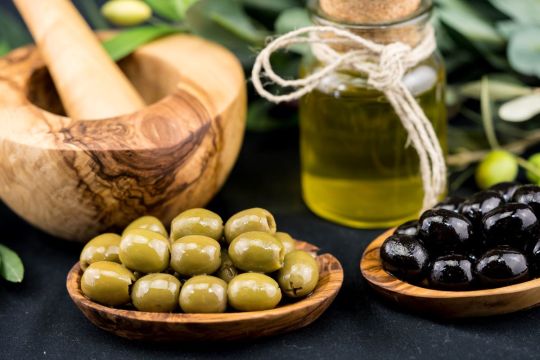
View On WordPress
#anti-inflammatory#antioxidants#extra virgin olive oil#healthy fats#heart health#Mediterranean diet#polyphenols
0 notes
Text
Nourish Your Beauty: The Ultimate Fall Vegetable Guide
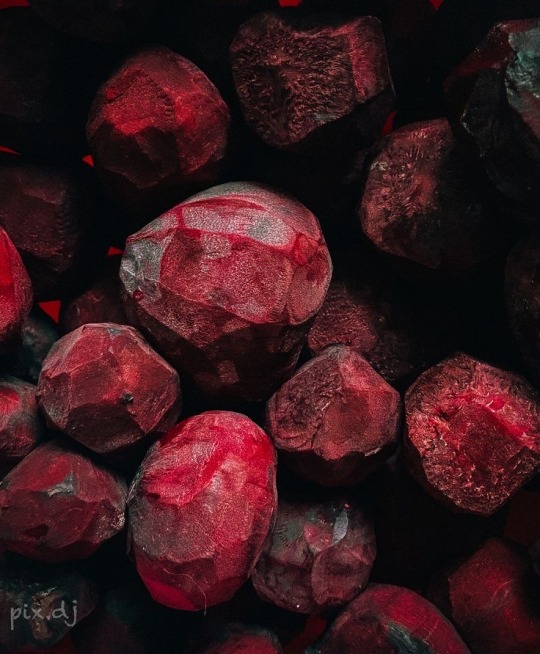
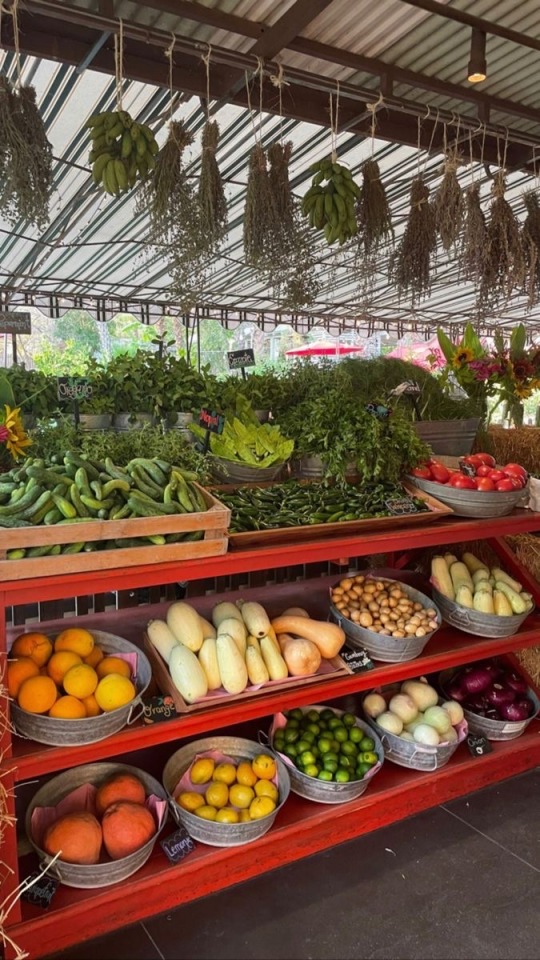

As the seasons shift, so do our nutritional needs—and the vegetables that thrive in the cooler months are packed with vitamins and minerals perfect for keeping your skin glowing and your health strong. For the Feminine Woman, integrating seasonal produce into your diet not only nourishes your body but also radiates beauty from within. Here are the best fall veggies to stock up on and their incredible benefits for both your health and your skin.
1. Sweet Potatoes
Sweet potatoes are rich in beta-carotene, which your body converts into Vitamin A—a key nutrient for maintaining healthy skin. Vitamin A helps prevent dry skin, keeps it soft, and promotes a youthful appearance by encouraging cell turnover.
Beauty Benefits:
• Glowing Skin: Beta-carotene protects your skin from UV damage and gives it a natural, radiant glow.
• Anti-aging: The high antioxidant content fights free radicals, reducing the appearance of wrinkles.
• Hydration: The Vitamin C in sweet potatoes aids in collagen production, helping to keep skin plump and moisturized.
How to Use: Roast sweet potato slices with olive oil, rosemary, and a pinch of sea salt for a simple yet delicious side dish.
2. Kale
Kale, the queen of greens, is one of the most nutrient-dense vegetables you can add to your diet in fall. It’s loaded with Vitamins C, E, and K, which are crucial for skin health, elasticity, and wound healing.
Beauty Benefits:
• Cleanses Your Skin: Kale’s high fiber helps to detoxify the body, leading to clearer, more even-toned skin.
• Fight Acne: The Vitamin C in kale reduces inflammation, making it a perfect addition to combat blemishes.
• Skin Elasticity: Vitamin K helps with skin elasticity, reducing dark circles and puffiness under the eyes.
How to Use: Add kale to a smoothie for a nutrient boost or sauté it with garlic for a quick, nutrient-packed side.
3. Butternut Squash
Butternut squash is high in Vitamin E, beta-carotene, and potassium, which help your skin stay hydrated, soft, and smooth. It’s perfect for preventing signs of aging while keeping your skin firm.
Beauty Benefits:
• Hydrated Skin: Butternut squash helps retain moisture in your skin due to its rich potassium content.
• Even Skin Tone: Its Vitamin E helps even out your complexion and reduces hyperpigmentation.
• Firmness: The collagen-boosting properties of Vitamin C in this squash keep your skin looking firm and youthful.
How to Use: Roast butternut squash and blend it into a creamy soup or cube it for a hearty salad.
4. Brussels Sprouts
Brussels sprouts are often underrated but are a powerhouse when it comes to skin health. Rich in Vitamin C, Brussels sprouts promote collagen production, which helps maintain your skin’s firmness and elasticity.
Beauty Benefits:
• Brighter Skin: Vitamin C boosts your skin’s radiance, making it look brighter and more youthful.
• Collagen Boost: Collagen production is essential for skin structure and elasticity, reducing sagging and fine lines.
• Detox: Brussels sprouts help detoxify the skin, flushing out harmful toxins and leaving your complexion clear.
How to Use: Roast Brussels sprouts with balsamic vinegar for a tangy, crunchy side dish that’s perfect for fall.
5. Beets
Beets are known for their blood-purifying properties, which lead to clearer, healthier skin. They’re also loaded with antioxidants that prevent signs of premature aging.
Beauty Benefits:
• Glowing Skin: Beets help boost blood circulation, resulting in a natural flush and radiant complexion.
• Detox Power: The high iron content in beets helps detoxify the body, keeping skin clear and blemish-free.
• Anti-Inflammatory: Beets’ anti-inflammatory properties reduce puffiness and redness.
How to Use: Add roasted beets to salads or blend them into smoothies for a pop of vibrant color and nutrients.
Incorporating these seasonal veggies into your fall diet will not only boost your health but also enhance your beauty from the inside out. These nutrient-packed powerhouses will keep your skin hydrated, youthful, and glowing as the temperatures drop.
So, head to your local farmer’s market, stock up on these fall essentials, and let your natural beauty shine!
#hbfsociety#highvaluewomen#nutrition#blackselfcare#blackfemininewomen#highmaintenance#self care#black femininity#high maintenance#healthyliving#healthy eating#beautyhacks
374 notes
·
View notes
Text
Superfoods you should incorporate in your diet:
Superfoods are nutrient-dense foods that are considered beneficial for your health due to their high concentration of vitamins, minerals, antioxidants, and other beneficial compounds.
Combine these superfoods with a variety of other whole foods to ensure you're getting a wide range of nutrients. Also, be mindful of portion sizes and any individual dietary restrictions or allergies you may have.
Berries: Blueberries, strawberries, raspberries, and other berries are rich in antioxidants, fiber, and vitamins.
Leafy greens: Spinach, kale, Swiss chard, and other leafy greens are packed with vitamins, minerals, and fiber. They are low in calories and provide important nutrients like vitamin K, vitamin C, and folate.
Cruciferous vegetables: Broccoli, cauliflower, Brussels sprouts, and cabbage are part of the cruciferous vegetable family. They contain compounds that may help reduce the risk of certain cancers.
Nuts and seeds: Almonds, walnuts, chia seeds, flaxseeds, and hemp seeds are excellent sources of healthy fats, protein, fiber, and various vitamins and minerals.
Fish: Fatty fish like salmon, sardines, and mackerel are rich in omega-3 fatty acids, which are beneficial for heart health and brain function.
Whole grains: Quinoa, brown rice, oats, and whole wheat are examples of whole grains that provide fiber, vitamins, and minerals.
Legumes: Beans, lentils, chickpeas, and other legumes are high in fiber, protein, and various nutrients. They are also a good source of plant-based protein.
Turmeric: This spice contains curcumin, a compound with potent anti-inflammatory and antioxidant properties.
Green tea: Green tea is rich in antioxidants called catechins and is believed to have various health benefits, including improved brain function and a lower risk of certain diseases.
Dark chocolate: Dark chocolate with a high cocoa content (70% or higher) is a source of antioxidants and may have positive effects on heart health and mood.
Avocado: Avocados are rich in healthy fats, fiber, and various vitamins and minerals. They also provide a good source of potassium.
Greek yogurt: Greek yogurt is a protein-rich food that also contains beneficial probiotics, calcium, and vitamin B12.
Sweet potatoes: Sweet potatoes are packed with vitamins, minerals, and fiber. They are an excellent source of beta-carotene, which is converted into vitamin A in the body.
Garlic: Garlic contains sulfur compounds that have been associated with potential health benefits, including immune support and cardiovascular health.
Ginger: Ginger has anti-inflammatory properties and is commonly used to aid digestion and relieve nausea.
Seaweed: Seaweed, such as nori, kelp, and spirulina, is a rich source of minerals like iodine, as well as antioxidants and omega-3 fatty acids.
Pomegranate: Pomegranates are packed with antioxidants and are believed to have anti-inflammatory properties. They are also a good source of vitamin C and fiber.
Cacao: Raw cacao is the purest form of chocolate and is rich in antioxidants, flavonoids, and minerals. It can be enjoyed as nibs, powder, or in dark chocolate form.
Quinoa: Quinoa is a gluten-free grain that provides a complete source of protein, along with fiber, vitamins, and minerals.
Extra virgin olive oil: Olive oil is a healthy fat option, particularly extra virgin olive oil, which is high in monounsaturated fats and antioxidants.
Chia seeds: Chia seeds are a great source of fiber, omega-3 fatty acids, and antioxidants. They can be added to smoothies, yogurt, or used as an egg substitute in recipes.
Beets: Beets are rich in antioxidants and are known for their vibrant color. They also contain nitrates, which have been shown to have beneficial effects on blood pressure and exercise performance.
Matcha: Matcha is a powdered form of green tea and is known for its high concentration of antioxidants. It provides a calm energy boost and can be enjoyed as a tea or added to smoothies and baked goods.
Algae: Algae, such as spirulina and chlorella, are nutrient-dense foods that are rich in protein, vitamins, minerals, and antioxidants. They are often consumed in powdered or supplement form.
Fermented foods: Fermented foods like sauerkraut, kimchi, kefir, and kombucha are rich in beneficial probiotics that support gut health and digestion.
Maca: Maca is a root vegetable native to the Andes and is often consumed in powdered form. It is known for its potential hormone-balancing properties and is commonly used as an adaptogen.
Goji berries: Goji berries are small red berries that are rich in antioxidants, vitamins, and minerals. They can be enjoyed as a snack or added to smoothies and oatmeal.
Hemp seeds: Hemp seeds are a great source of plant-based protein, healthy fats, and minerals like magnesium and iron. They can be sprinkled on salads, yogurt, or blended into smoothies.
Moringa: Moringa is a nutrient-dense plant that is rich in vitamins, minerals, and antioxidants. It is often consumed as a powder or used in tea.
Mushrooms: Certain mushrooms, such as shiitake, reishi, and maitake, have immune-boosting properties and are rich in antioxidants. They can be cooked and added to various dishes.
#health tips#healthy lifestyle#health and wellness#nutrients#healthy life tips#healthy life hacks#healthy diet#level up journey#high value mindset#health is wealth#levelupjourney#glow up tips#glow up#nutrition#healthy living
2K notes
·
View notes
Text
Aphrodite Rose Lip Oil 💋

Ingredients:
2tsp petroleum jelly
3 drops rose oil
1 drop collagen serum
2 drops argan oil (can replace with olive, jojoba or almond oil)
1/2 tsp coconut oil
1/4 tsp honey
Vitamin E capsule
2 drops vanilla essence for flavour (optional)
1/2tsp beeswax for added firmness (optional, use if you want a balm rather than an oil)
A sprinkle of body or edible glitter (optional)
Mix all ingredients together, slitting the vitamin E capsule open and squeezing the contents into the mix.
As you stir, say: "Lady Aphrodite, whose beauty glows, please make my lips as soft as the rose."
Put in an empty lip balm container (the one I used is from a travel sized set of empty cosmetics containers). It will be goopy at first, so put in the fridge until the coconut oil and petroleum jelly solidifies. If still goopy add more petroleum or 1/2tsp of beeswax. Apply morning and night for extra soft and rosy lips.
Coconut oil: moisturising, anti-inflammatory
Petroleum jelly: locks in moisture
Rose oil: heavily associated with Aphrodite, pleasant smell, soothing, adds a pink tint
Vanilla extract: adds flavour and scent
Argan oil: rich in vitamin E, fatty acids, moisturising
Collagen: improves elasticity and texture, moisturising
Honey: helps retain moisture, anti-inflammatory, adds sweetness, associated with Aphrodite
Vitamin E: antioxidant, healing, moisturising
Body glitter: sparkle ✨
#glamour witch#aphrodite devotion#aphrodite aesthetic#aphrodite worship#aphrodite altar#aphrodite goddess#aphrodite#hellenic worship#hellenic deities#hellenic pagan#hellenism#paganism#aphrodite devotee#aphrodite offerings#witchblr#spellwork#spell#beauty spells#glamour spells#gods
188 notes
·
View notes
Text
Healthy Skin



Cleansing and Moisturizing
Have short showers in warm water. Avoid long showers with hot water because it can strips helpful and necessary oils from your skin.
Wash your face twice daily. You should wash your face in the morning when you get up, and in the evening before going to bed.
Pat your skin dry. Instead of rubbing dry with a towel, gently pat your skin with a towel and let the remaining moisture air dry. This applies to both the skin on your face and on your body.
Exfoliate once or twice a week.
Remove your makeup before going to sleep. This will prevent breakouts.
Clean your makeup brushes regularly. This will prevent the build-up and spread of acne-causing bacteria.
Avoid touching your face as much as possible.
Healhy Diet
Fruits and vegetables. They are great for your skin and you body, since they are full of vitamins and antioxidants.
Food rich in omega. Fats are necessary for healthy skin, especially omega-3 and omega-6 fatty acids. Good sources of omega include: walnuts, olive and canola oil, flaxseeds, sardines, mackerel and salmon.
Food rich in antioxidants and selenium. they prevent damage done by free radicals, which contribute to wrinkles, tissue damage, and dry skin. Foods high in antioxidants include: whole grains, berries, apricots, beets, squash and sweet potatoes, tangerines, beans, and olive oil. While foods that contain selenium include: whole-wheat pasta, button mushrooms, beef and turkey, oysters, shrimp and crab, snapper and cod, and some other fish.
Food rich in coenzyme Q10. Coenzyme Q10 is an antioxidant that be found in: whole grains, fish, organ meats, and soybean, canola, and sesame oils.
Food rich in flavonoids. Flavonoids have both antioxidant and anti-inflammatory properties. It can be found in: dark chocolate and green tea.
Drink water. At least 2L daily.
Avoid added sugars. As well as processed or refined carbohydrates and unhealthy fats.
Lifestyle
Get 7 to 9 hours of sleep each night. Not getting enough sleep can make your skin appear dull and sallow. when we sleep, our bodies secrete certain growth hormones, and this leads to collagen production.
Reduce your stress levels. Yoga, meditation and breathing exercises can help you to relieve stress.
Exercise on a daily basis. Exercise increases blood flow to your skin and supplies it with oxygen and nutrients.
Protect your skin from the sun. A minimal amount of UV exposure is necessary for vitamin D production (20 minutes is enough for most people), but too much sun can damage your skin. Choose a sunscreen with a minimum of 15 SPF, wear it every day and avoid the sun between 10 am and 2 pm.
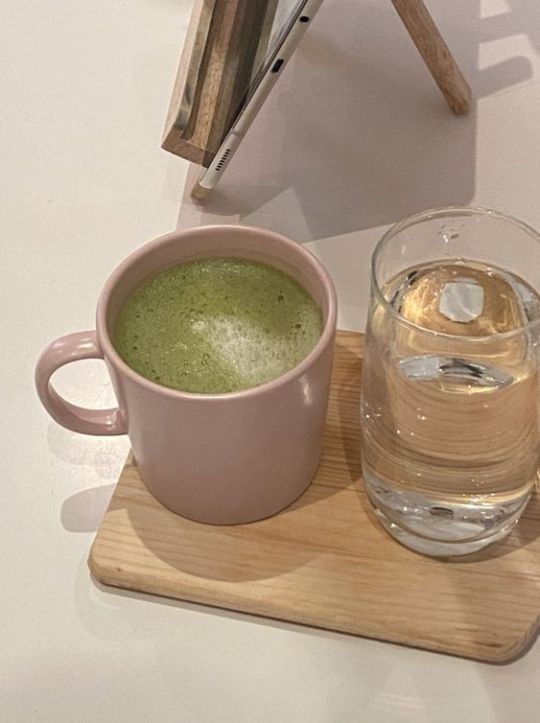
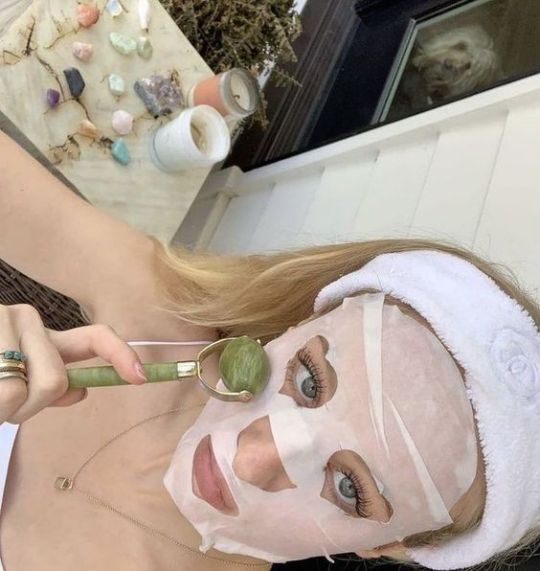
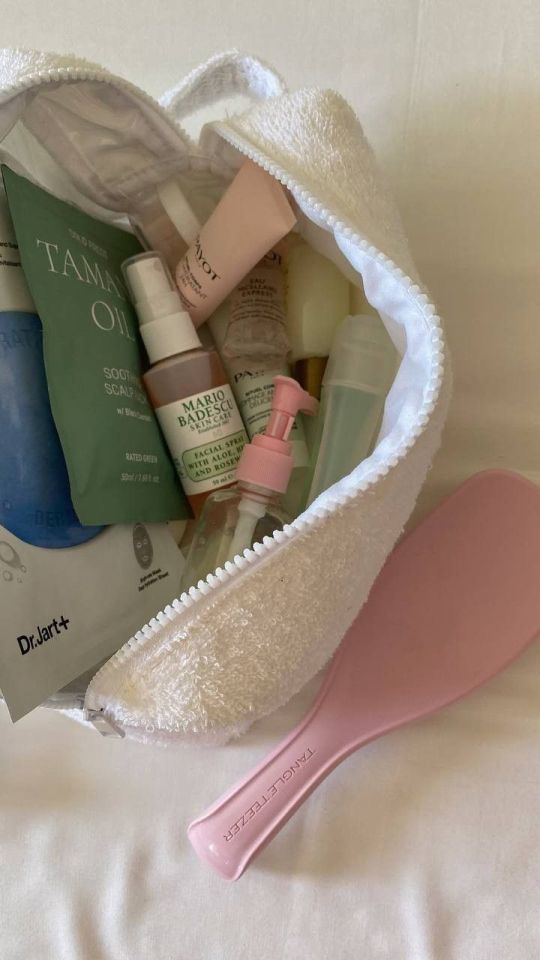
#coquette#pink pilates girl#hyper feminine#victoria secret angel#girly girl#self care#self improvement#self healing#self love#high maintenance#glow up#cinnamon girl#clean girl#dream girl#green juice girl#it girl#pinterest girl#that girl#pink blog#pink pilates princess#pinterest#aestethic#feminine#feminine energy#soft feminine#skincare#healthy
622 notes
·
View notes
Text
Ways to use magickal oils: for witches and non-witches
In your beauty routine:
Depending on the carrier oil, spell oils can be a great addition to skin care and hair care! Some carrier oils provide a lot of skin and hair benefits.
Castor oil contains triglycerides, which help maintain moisture in the skin. This can help with dry skin. Castor oil can also be applied generously as a hair mask and wash off, or apply very liberally to the ends of hair to help with frizz. This is depending on hair type.
Grapeseed oil is an effective treatment to decrease split ends. On the skin, grapeseed oil can help with breakouts, treat dry skin, and gently fade some scars. It’s also non-comedogenic meaning it won’t clog pores. This could be a good option for someone with oily skin.
Sweet almond oil has a lot of vitamins, minerals, fatty acids, and antioxidants that can sooth both the skin and hair. It can help approve the appearance of dry and irritated skin.
Jojoba oil is anti-inflammatory and can reduce redness, help with chaffing, and keep skin calm. For hair, it can strengthen hair strands and reduce hair porosity buildup. It is both antifungal and antibacterial.
Sunflower seed oil can make hair shiny and strong. It can help tame frizz as well as treat dandruff. When used on the skin, it can help skin retain moisture.
*Always be wary of your skin sensitivities and allergies when buying or making your own oil blends.
Ways to use them in your beauty routine:
Add a few drops to your bath for aromatherapy.
Mix a few drops into your liquid soap (great for cleansing and/or protection!)
Mix a few drops in your palm with your favorite lotion. Rub it into your skin while saying affirmations.
Deposit a few drops through your hair while damp.
Dab it on your pressure points to use as perfume.
If you make soap, add a few drops into your soap for a magickal boost.
In your cooking:
Some carrier oils can be great to cook with! *Make sure not to add essential oils to these blends and use food safe herbs. You’re responsible for your own allergens.
Olive oil is already a pantry staple for many people. Try making an oil blend steeping your favorite kitchen herbs and spices in olive oil to use in your cooking.
Avocado oil is another great oil you can do this with if you prefer.
Coconut oil is solid at room temperature, but that doesn’t mean you can’t use it as an oil blend. Heat up the amount you want in a pot and add your herbs. Keep the heat low to infuse your herbs then place into a jar to solidify.
In magick:
Oils are super versatile and they’re a staple for many witches. The most common way they’re used is to anoint candles for spells and rituals. This can even go as far as anointing deity candles as an offering.
They can also be used to anoint objects. By taking a small amount of oil and rubbing it onto an object, you can add energy and charm it with your intention. This works for talismans as well.
You can also anoint yourself! Certain points on the body can be anointed depending on your intention. Anoint your throat with a confidence oil before giving a presentation to aid in communication; anoint your forehead with a psychic oil to aid in divination; anoint your pressure points with a love oil to draw someone in.
The possibilities are endless.
#witchblr#witches of tumblr#witch community#witchcraft#book of shadows#grimoire#magickal oils#spell oils#ritual oil
74 notes
·
View notes
Text



It TIIMEEES!
You all know my passion for beauty and self care especially when it is DIY ! Like there is nothing better than taking care of yourself in the comfort of your home ( except maybe a 5 star but hey we do we what we can )
So here is few homemade recipe to take care of yourself right in your casa babes!
Hair mask :
1 ripe avocado
2 tablespoons honey
2 tablespoons olive oil (or coconut oil)
Optional: a few drops of essential oil (like lavender or rosemary)
Instructions:
Prepare the Avocado: Cut the avocado in half, remove the pit, and scoop the flesh into a mixing bowl.
Mash the Ingredients: Use a fork or a blender to mash the avocado until smooth.
Mix in Other Ingredients: Add the honey and olive oil (and essential oil, if using) to the mashed avocado. Mix well until you have a creamy consistency.
Apply the Mask: Start with clean, damp hair. Apply the mask evenly, focusing on the ends and any dry areas. You can use a comb to help distribute it.
Let It Sit: Cover your hair with a shower cap or a towel to keep the mask warm. Leave it on for 30 minutes to an hour.
Sugar wax :
2 cups granulated sugar
1/4 cup water
1/4 cup lemon juice (freshly squeezed is best)
Instructions:
Combine Ingredients: In a medium saucepan, mix together the sugar, water, and lemon juice.
Heat the Mixture: Place the saucepan over medium heat. Stir constantly until the sugar dissolves.
Cook the Mixture: Once dissolved, stop stirring and let it boil. Keep an eye on it, as it can bubble up. Cook for about 8-10 minutes, or until the mixture turns a golden amber color. Use a candy thermometer to check the temperature; it should reach about 240°F (115°C).
Cool Down: Remove the saucepan from heat and let the mixture cool for a few minutes. Pour it into a heat-safe container and allow it to cool completely.
Check Consistency: Once cooled, the wax should be pliable but not too sticky. If it's too hard, you can add a little water and heat it again briefly.
Face mask :
2 tablespoons plain yogurt (preferably unsweetened)
1 tablespoon honey
1 tablespoon oatmeal (finely ground)
Optional: a few drops of essential oil (like tea tree or lavender)
Instructions:
Mix Ingredients: In a bowl, combine the yogurt, honey, and oatmeal. Mix until you have a smooth paste.
Add Essential Oil: If desired, add a few drops of your chosen essential oil and mix again.
Apply the Mask: Clean your face and gently apply the mask evenly, avoiding the eye area.
Let It Sit: Allow the mask to sit for about 15-20 minutes.
Rinse Off: Rinse your face with warm water, gently massaging in circular motions to exfoliate.
Finish with a splash of cool water to close the pores.
Detox shot :
Ingredients:
1-inch piece of fresh ginger (helps with digestion and inflammation)
1/2 lemon (rich in vitamin C, supports immune function, and helps with digestion)
1 tablespoon apple cider vinegar (supports digestion and balances pH)
1/4 teaspoon turmeric powder (anti-inflammatory and antioxidant properties)
A pinch of cayenne pepper (boosts metabolism and circulation)
1 tablespoon honey or maple syrup (optional, for sweetness)
Instructions:
Prepare the ingredients:Grate or finely chop the fresh ginger.Squeeze the juice from the lemon.
Blend: In a blender, combine the ginger, lemon juice, apple cider vinegar, turmeric powder, cayenne pepper, and honey (if using).Add about 2–3 tablespoons of water to help with blending.
Strain (optional):If you prefer a smoother shot, strain the mixture through a fine mesh sieve or cheesecloth to remove any pulp.
Serve:Pour into a small shot glass (about 1 to 2 ounces).Stir well before drinking, as some ingredients might settle at the bottom.
So girlies, i hope this helps and see you on my next blog!!!
#becoming that girl#girlblogging#it girl#manifesting#dream girl#self care#self improvement#digital journal#late twenties#black girls of tumblr#home remedies#self growth#self love#self obsessed#it girl lifestyle#im just a girl#just girly thoughts#just girly things#girl blogger#work in progress#becoming the best version of yourself#beauty treatments#beauty tips#law of assumption#law of attraction#manifesation#divine feminine#hyper feminine#female hysteria#ghetto fabulous
40 notes
·
View notes
Text

Grilled Mackerel With Lemon-Dill Yogurt Sauce
Ingredients:
* 2 mackerel fillets
* 1 tablespoon olive oil
* Salt and pepper to taste
* 1/2 cup Greek yogurt
* 1 clove garlic, minced
* 1 tablespoon lemon zest
* 1 tablespoon chopped dill
* Salt and pepper to taste
* 1/4 red onion, thinly sliced
* 1/2 cucumber, thinly sliced
* Handful of mixed greens
* 1 tablespoon olive oil
* 1/2 lemon, juiced
* Salt and pepper to taste
Instructions:
* Drizzle mackerel fillets with olive oil, salt, and pepper.
* Grill or pan-sear until cooked through.
* Combine Greek yogurt, minced garlic, lemon zest, and chopped dill in a bowl.
* Season with salt and pepper to taste.
* Thinly slice red onion and cucumber.
* In a large bowl, combine mixed greens, red onion, and cucumber.
* Drizzle with olive oil and lemon juice.
* Season with salt and pepper.
* Place a bed of salad on a plate.
* Top with a grilled mackerel fillet.
* Dollop with lemon-dill yogurt sauce.
Nutritional Benefits:
* Mackerel: Provides a rich source of omega-3 fatty acids, protein, and essential vitamins and minerals.
* Yogurt: Offers protein, calcium, and probiotics for gut health.
* Lemon: Contains vitamin C, an antioxidant.
* Dill: Provides antioxidants and anti-inflammatory properties.
* Vegetables: Offer vitamins, minerals, and fiber.
This dish is a flavorful and nutritious way to enjoy the benefits of mackerel. The combination of grilled fish, creamy yogurt sauce, and fresh vegetables creates a well-balanced meal.
#food#food photography#foodpics#foodie#foodmyheart#foodlover#tw food#healthy food#food fight#comfort food#fast food#food for thought#lunch recipes#pasta recipes#pasta recipe#salad recipes#soup recipe#recipe#reciprocidade#reciprocity#recipies#recipes#cozy autumn#cozy fall#cozy art#cozy cozy#healhtylifestyle#healthy salad recipes#healthy lunch ideas#healthy lunch
37 notes
·
View notes
Text


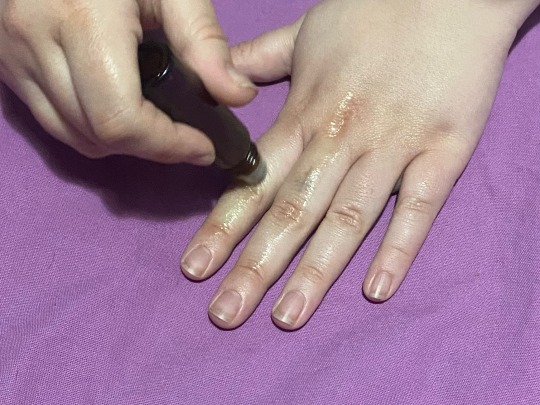
devil’s club rollerballs for sale!
i have about 10 devil’s club and white willow bark rollerballs left, these bottles are 10 ml, and the oil is jojoba and olive oil infused with devil’s club bark and white willow bark. devil’s club is a wonderful natural pain reliever, and willow bark is anti inflammatory, this is a combo i made specifically with artists and generally people who work with their hands in mind. the oils absorb into your skin faster than a salve, so you can continue working without worrying about getting your work greasy, and still feel relief. i personally use this for my carpal tunnel, and my aunt, mom, and both grandmas use it for arthritis and back pain.
ingredients: devil’s club bark, white willow bark, jojoba oil, cold pressed olive oil.
$17 + $5 for US shipping, if you are in the seattle area we can arrange local pickup at one of my future market dates. if you are interested either send me a message here or email me at [email protected]
67 notes
·
View notes
Text
Medicinal Remedies
Medicinal Remedies-- This is a LONG one!
NOTE: This article is about 20 of my favorite medicinal healing herbs to grow in most garden areas and types of soil. There are 100’s more, though, that I just couldn’t include because of space. Enjoy this rundown of 20 of my favorites.

1) Calendula:
Calendula is one of my top five favorite herbs of all time. It's sunny yellow or orange face can't help but make me smile. In summer time, it grows like crazy, just about anywhere, and like other flowers, the bees love it.
Calendula has some super skin healing and strengthening properties, and I always have some infusing in olive oil in a sunny window for use in salves, soaps, and other body products.
Calendula is also edible, and it's so fun to toss some blooms in your salad! It really brightens things up and adds excellent color. I love Calendula.
Calendula just makes you smile.
2) Cayenne:
Here is another herb I think should be in every garden. Cayenne is a very hot and pretty red pepper with some excellent culinary uses for adding spice to foods.
It's also great for helping with circulatory problems, can be used to help stop bleeding since it's a hemostatic herb, and has been shown to be useful in helping slow or even stop a heart attack until help can arrive.
It's also a very attractive plant, and the bright red of the pepper is just gorgeous mixed Into the dark green of the plant's leaves. This is one herb you should definitely grow if you can, and have handy in your herbal medicine chest.
Cayenne grows like crazy, especially in warmer climates. They dry well, too.
3) Chamomile:
Like Lavender, what would an herbal garden be without sweet Chamomile? It's honey scent and sweet taste are an absolute pleasure. Besides that....Chamomile is a popular relaxant and mild sedative herb.
Need to de-stress? Drink a bit of Chamomile tea!
Chamomile is also useful as an anti-inflammatory, as it contains high levels of azulene. It helps with pain relief, including for arthritis. If you are heading to bed and are bothered by mild pain, try drinking some chamomile tea! In one clinical study, this helped 10 out of 12 people fall into a restful sleep. (Gladstar)
Growing Chamomile can be tricky in very hot climates. It likes full sun, but a cooler climate. Chamomile is also best grown in less maintained soil and doesn't need the rich fertilization other plants require.
4) Chickweed:
Chickweed is another one of those "weeds" that is completely misunderstood and has some excellent medicinal qualities.
It's Latin name, (stellaria) means "star," and that is because of its small, pretty starlike white flowers. It's easy to grow, and has many uses.
Chickweed supports liver and kidney health due to its high nutrition and diuretic properties. It's also wonderful in salves for healing skin issues, including rashes, eczema, and very dry skin.
Chickweed is a great diuretic and blood purifier.
5) Dandelion:
This prolific weed, as some people see when they notice Dandelion in their yard, is actually a powerfully helpful medicinal herb! Dandelion is terrific for your liver and kidney health, having diuretic properties.
It's also an edible plant! You can roast the roots and add it to teas and even your coffee for a delicious flavor that also packs a healthy punch. The leaves can be eaten in salads and other foods.
6) Feverfew:
Feverfew has lovely white flowers and at least where I live, is rather invasive. I don't mind, though, because it has a great number of medicinal benefits.
As its name connotes, feverfew is helpful with reducing fevers. Most recently, however, feverfew has become rather well-known for helping with migraines, both preventing and reducing the intensity and time.
One of my favorite teas to provide for people who suffer from migraines is: 1 part feverfew, 1 part spearmint, and 1 part lemon balm. This is a soothing, nervine combination, that along with the powers of feverfew, can be used as daily tonic.
Feverfew is also great for minor bug bites. Just apply the tincture topically. Since it has mild pain relieving properties, it will help with the discomfort too.
7) Garlic:
Garlic is one of the BEST all around medicinal herbs anyone can grow, in my opinion. It's useful for treating colds, flus, sore throats, and digestive issues. Garlic boosts the immune system by increasing and stimulating the production of white blood cells.
Garlic is antiseptic, anti-bacterial, and vermifuge (kills parasites). It is also useful as a blood purifier and helps promote healthy circulation. It may also help regulate blood sugar levels in those with type 2 diabetes.
Besides all these wonderful benefits, garlic is delicious! It's added to so many foods and dishes because of the flavor it imparts. Granted, using garlic medicinally is different than in culinary uses, but if you really want to "eat thy medicine," as Hippocrates famously stated, garlic is a great place to start.
8) Ginger:
Oh, what would the herb world be without Ginger? This sweet and spicy pungent herb is actually a rhizome, not a root, as many believe. The useful part grows under ground, so is often confused.
Ginger is stimulating and is a great additive for teas, tinctures, and fermented foods, as well as culinary uses. Ginger is anti-inflammatory, decongesting, and increases circulation, promoting warmth. Ginger is also excellent for flatulence and stomach issues, including nausea.
Ginger likes a tropical environment---hot and humid. Therefore, unless you live down South, Ginger would most likely need to be grown in a green house.
9) Lavender:
What would the herbal world be without lavender? It's good for SO many things. Lavender smells wonderful, the bees love it, it's great for medicinal uses, AND it's a gorgeous flower. Lavender is useful for air freshening and cleaning the air or freshening closed up places such as drawers. It's popular in sachets for this reason.
Lavender is actually relatively hardy, growing well in Zones 5 through 8. If you are in a colder zone, be sure to plant your lavender in an area where it will get plenty of sunshine and be as warm as possible. If your winters are rough, you'll need to provide your lavender with some type of protection, especially from harsh winds.
I had some planted in pots here in the mountains, and it did very well all summer long. Even through snows, it was fine. But we get wind speeds over 125 miles an hour at times, and lavender just didn't last through that. Not much will, I guess.
Lavender is useful for so many things---AND it smells incredible.
10) Lemon Balm:
Lemon Balm....I LOVE this species of mint. It smells lovely, the bees love it, and it grows well nearly everywhere. Lemon Balm has a pleasant lemony taste and is a great additive in herbal teas, both for the nutritive value as well as the soothing nature and relaxing effects it has on the body.
11) Marshmallow:
This probably isn't included in too many herbalist's garden lists, but I think Marshmallow is seriously necessary. It's a demulcent and soothing herb, and it complements "hotter" herbs very well. It also soothes inflammation in mucous membranes and is one of my favorite herbs to use for allergy blends or teas for any kind of inflammation in the body for this reason.
Marshmallow is an upright plant, similar to a very small hollyhock. In fact, if you can grow hollyhocks where you are---you can use it pretty much interchangeably with Marshmallow as their chemical constituents are very similar.
The flowers are light pink and very pretty, too. The entire plant is edible and useful for medicinal purposes. Go ahead and throw a few flowers into your salad for a beautiful and surprising presentation!
Marshmallow is a demulcent anti-inflammatory. Plus, it's pretty.
12) Mullein:
This is yet another plant many see as just a weed, but has some truly wonderful medicinal qualities. Mullein is a plant that grows from a rosette of fuzzy large leaves into a tall stalk (sometimes as high as 7 feet tall) and is covered with yellow flowers in mid-summer.
Mullein does best in full sun, with lots of water, in cooler areas. It grows really well in the creek beds up here in our mountains, but I've heard it is very common in almost all places. It's worth trying to cultivate, in my opinion, if you don't have it growing naturally in your area.
Mullein is one of the best herbs you can use to support and heal the respiratory system and illnesses that affect the lungs, sinuses, and breathing. It's useful as a tea, tincture, and the large leaves can be used in an emergency to cover a poultice.
In my opinion, Mullein is the premier herb for respiratory issues.
13) Oregano
Oregano seems to be the bane of many gardener's existence. They plant it, and it just goes crazy. I can't tell you how many neighbors, family members, and friends have given me Oregano from their yards over the years! And I'm glad to have it! The thing with Oregano is you have to know how to manage it.
Oregano is a fabulous culinary herb, and if you have ever had pizza or marinara sauce, then you've tasted this delicious Mediterranean herb. Oregano grows best in warm, dry climates, but I have found in my experience that it is quite hardy and can survive winter lows in the single digits (at least it does in my yard).
Oregano (also known as Mountain of Joy in Greek) has some excellent medicinal uses, including having anti-viral, anti-biotic, anti-fungal properties, as well as being very high in anti-oxidants. It's a great skin care herb and also a digestive aid.
Oregano can be used in many forms, too: As a tincture, an herbal infused oil, eaten in foods, and as an essential oil. These all have different strengths, potencies, and uses.
The tincture is an easy way to use the herb medicinally, along with making or using in an herbal tea.
14) Peppermint:
Super easy to grow just about anywhere, Peppermint is a spreading perennial that has the propensity to take over your garden if you allow it! It's spicy, pungent scent is well known to just about everyone, since it's a popular culinary additive in many foods and candies.
Medicinally, Peppermint is useful for aiding digestion and getting rid of flatulence (gas). It has mild anti-spasmodic properties, so if you are experiencing cramps, especially digestive types or menstrual cramps, it can be very helpful.
15) Plantain:
Here is another weed that many people find repugnant, but that is actually an incredibly useful medicinal herb!
According to Rosemary Gladstar, Plantain grows everywhere, and if you invite it in, it will definitely show up.
Plantain is great for liver health, detoxifying and cleansing the blood, and drawing out toxins. I like to infuse it in oil for use in healing salves.
Like Dandelion, this easy to find weed is edible and useful.
16) Rosemary:
Rosemary is a famous culinary herb, and is great for use on red meats and very pungent dishes. Besides this, rosemary has been proven to be helpful for the brain, especially memory functions.
It's high in anti-oxidants, and has mild analgesic (pain relief) properties. Rosemary is a stimulant herb, and is helpful with circulation and low blood pressure. People with high blood pressure need to exercise caution using rosemary medicinally.
Rosemary grows best in hot, dry climates and is native to the Southern European countries.
Besides being a pungent and delicious culinary herb, rosemary provides medicinal qualities and enhances memory.
17) St. John's Wort:
St. John's Wort is a misunderstood plant, in my opinion. It went through a popular phase a few years ago and was touted as being the new natural anti-depressant. St. John's Wort can absolutely help with feelings of mild depression, sadness, grief, and Seasonal Affective Disorder (SAD), but it's not a cure-all.
Important to know---St. John's Wort can interact with certain drugs, so be sure you discuss usage with your doctor (as you should with any of these herbs mentioned).
St. John's Wort is also great for neuralgia, and I personally use it as part of my back pain and sciatica regimen with excellent results. I also use it in a tincture form to lift my spirits if I'm feeling down.
Besides all the medicinal qualities of St. John's Wort, it's a really pretty plant. You won't be able to grow it in a super hot area, however, at least it's unlikely. I tried growing it in Las Vegas, and it was a total fail. However, it does well here in the mountains in full sun or partial shade and the cooler climate.
One of my favorite ways to prepare St. John's Wort is as an herbal infused oil. The medicinal species (H. perforatum) releases bright red juices into the oil, creating the most lovely infused oil.
Another safety note for the garden: St. John's Wort has been shown to have potential for phototoxicity, especially in grazing animals if they eat too much. Just be aware and watch what your pastured animals eat.
St. John's Wort is a wonderful healing herb that positively affects the emotions.
18) Thyme:
Thyme, in my opinion, is one of the best plants to use in your garden. It attracts bees, smells lovely, and is incredibly useful for medicinal purposes. It's a small, spreading herb (although some species will grow upright) that is fairly hardy, so if you have rough winters, it may do just fine---you'll be seeing it again in the Spring, with it's pretty scented purple flowers.
Many herbalists forget all about using thyme as a preventative medicinal herb or for helping heal quickly from colds and flus---but it has been shown to fight off colds.
It also has disinfectant properties, and can be used as an effective wash for skin infections or as great sore throat rinse. For medicinal purposes, Thymus vulgaris or Thymus citriodorus (Lemon Thyme) are the best to use.
19) Valerian:
This stately flowering plant can grow to about four feet tall and has lacy white flower clusters. Not only is it a lovely addition to your garden, but it is very useful. It's a strong but safe sedative and is very useful for helping with anxious feelings, sleep issues, and pain relief.
Contraindications: Valerian has the opposite effect on some people, so if you are using it for the first time, do so on a the eve of a day that won't affect you much. These folks are rare, but there are definitely some that don't tolerate it well.
One of nature's best gifts---Valerian is lovely and it is an excellent safe sedative.
20) Yarrow:
Yarrow has many tiny flowers that grow in bunches, and feathery grayish leaves. It's a very pretty plant for your garden. Besides, the parts that grow above ground (leaves, stems, flowers) have medicinal purposes and have been used for thousands of years.
Yarrow is a vulnerary, hemostatic herb. Besides helping with healing and clotting of wounds, yarrow is good for helping reduce fevers, hay fever, and fighting colds. As a fever reducer, it is important to note that yarrow induces sweating, so if the person already has a hot fever, yarrow is probably not the best choice to use.
Article: healing harvest homestead Picture: Nikolaydonetsk – photodune . net
#witch#hearth witch#herbal magick#kitchen witch#witch blog#small business#pagan#herbs#kitchen witchery#etsy shop#witchy#witchcraft#witchyvibes#green witch#witch community#witchblr#pagan witch#witch aesthetic#witchcore#witchlife#witches#hellenic pagan#pagan community#paganism#paganblr#wicca#pagan altar
308 notes
·
View notes
Text
Sphagetti For YUU 🍝
Azul: Breaktime~ 🥰🥰
Azul and Lilia: Spaghetti? 😙
Azul and lilia:💀
Azul and lilia: Yuu do u want to eat my spaghetti 🥰?
Azul: are you competing with me? 😡
Lilia:are u threatened?~😏
Azul:bring it on..
Lilia:ahem~ my spaghetti has sauce made from FRESHLY picked tomatoes~ from the high mountains of~ italy 😌..what about yours?~
Azul:...😡..MY spaghetti has banana ketchup..with ANTIOXIDANTS..ANTI-HISTAMINE...ANTI-INFLAMMATORY.. ANTIBIOTIC! with glutathione and silymarine extract with ginko biloba-e 🥰
...but wait!..theres more 😈!...chicken LOLLIPOPS made with bouncy fresh spring chicken deep fried in olive oil 🤭
Lilia:*chuckling* THATS all you have?? Chicken lollipops? Hahaha! Like what the heeEecK~😂
..have some dessert that I concucted!!
Azul:CONCUCTED??!😰
Lilia:OHOHOHo~~ YessSs~ 😈
#twisted wonderland#twisted wonderland x reader#disney twst#twst yuu#disney twisted wonderland#twst azul#azul ashengrotto#lilia vanrouge#incorrect twisted wonderland#twst incorrect quotes
35 notes
·
View notes
Text
The King of Mushrooms: A Nutritional Powerhouse

In the realm of functional foods, mushrooms have emerged as a nutritional powerhouse, offering a plethora of health benefits. Among these, the King Oyster mushroom, scientifically known as Pleurotus eryngii, stands tall as a culinary delight and a nutritional champion. Let's delve into the nutritional profile of this extraordinary fungus.
A Nutritional Breakdown
King Oyster mushrooms boast a nutritional profile that rivals many conventional protein sources. Here's a breakdown of their key nutrients:
Protein: These mushrooms are a fantastic source of plant-based protein, making them an excellent choice for vegetarians and vegans.
Fiber: Rich in dietary fiber, King Oysters promote digestive health and satiety.
Vitamins and Minerals: They are packed with essential vitamins and minerals, including B vitamins, potassium, phosphorus, and selenium.
Low in Calories: Despite their nutritional density, King Oysters are low in calories, making them a guilt-free addition to your diet.
Health Benefits Beyond Nutrition
The nutritional prowess of King Oyster mushrooms extends beyond their basic nutrient profile. Here are some of the remarkable health benefits associated with these fungi:
Immune Boost: The beta-glucans present in King Oysters have been shown to stimulate the immune system, enhancing the body's defense mechanisms.
Antioxidant Power: These mushrooms are rich in antioxidants, which help combat oxidative stress and protect cells from damage.
Anti-inflammatory Properties: Certain compounds in King Oysters exhibit anti-inflammatory effects, reducing inflammation and promoting overall well-being.
Blood Sugar Regulation: Studies suggest that King Oysters may help regulate blood sugar levels, making them beneficial for individuals with diabetes.
Heart Health: The fiber, potassium, and antioxidants in these mushrooms contribute to heart health by lowering cholesterol levels and reducing the risk of heart disease.
Incorporating King Oyster Mushrooms into Your Diet
King Oyster mushrooms are incredibly versatile and can be incorporated into various dishes. Here are a few ideas:
Sautéed: Sauté them with garlic, olive oil, and herbs for a quick and flavorful side dish.
Grilled: Grill them to perfection, adding a smoky flavor that complements their meaty texture.
Steamed: Steaming preserves their delicate flavor and nutritional value.
Soups and Stews: Add them to soups and stews for a hearty and nutritious meal.
Pasta Dishes: Incorporate them into pasta dishes for a unique and satisfying flavor.
Conclusion
King Oyster mushrooms are a culinary treasure and a nutritional powerhouse. Their unique combination of nutrients and potential health benefits makes them a valuable addition to a balanced diet. So, the next time you're planning your meals, consider adding these royal fungi to your plate. Your taste buds and your body will thank you!
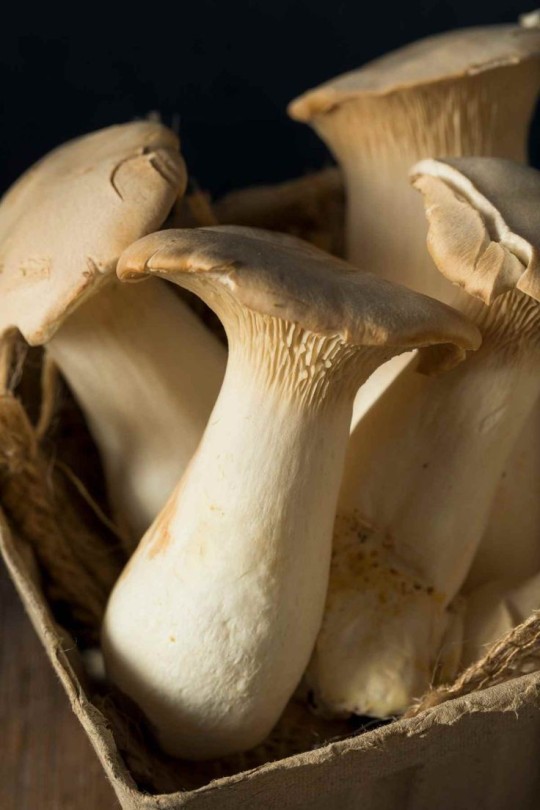
13 notes
·
View notes
Text
DIY: Summer Citrus Sugar Scrub
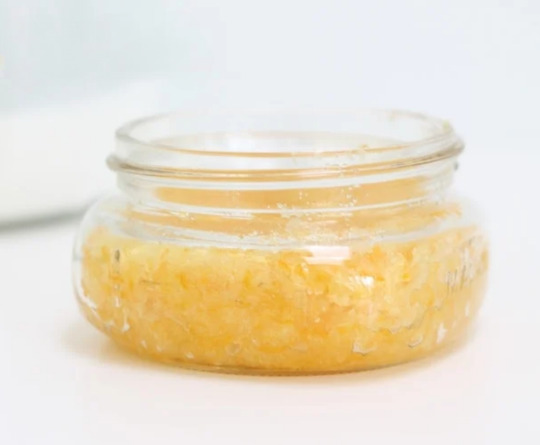
Rejuvenate and revive your skin with this easy citrus sugar scrub recipe. With only 3 ingredients you probably already have on hand, you’ll be ready to whip up this gentle exfoliating body scrub in no time!
Sugar Scrub, or body polish is a luxurious way to refresh your skin. It is so gentle that it can even be used on sensitive skin.
Exfoliating body scrub makes a great shower favor, quick gift, treat for yourself or a hostess gift when you are welcomed to a friend’s beach house. This jar will keep my skin happy all summer long!
Keep a jar of this sugar scrub by your kitchen to soothe your hands after washing dishes. It will rehydrate your skin from the harshness of the hot water and dish soap. Keep a jar of sugar scrub in the shower for a mini spa treatment up to 3 times a week!
Citrus Sugar Scrub Recipe Ingredients
It’s made with just a few ingredients, from your kitchen!
Sugar – 1/2 cup of regular white table sugar is perfect for this diy sugar scrub! It exfoliates your skin, gentling rubbing away dead skin cells leaving your skin feeling smooth and radiant.
Oil – I use 1/4 cup Vitamin E Oil in this recipe which is so good for your skin. Its anti inflammatory properties soothes and calms, while hydrating dry skin and working to heal any blemishes.
Citrus – Is so good for your body inside and out! Naturally full of vitamin C it leaves your skin with a beautiful glow! It also can help to lighten sun spots or other blemishes on your skin. I love the texture and beautiful color the citrus adds along with its amazingly refreshing scent! You can use the zest from one Orange, Grapefruit, or Lemon, or 2 Limes, in this recipe.
*** Zest is made from the top layer of a fruit peel. Always try to avoid the white pith. If you don’t have a zester, you can use a vegetable peeler to gently peel the top layer of your fruit. Then cut the strips into finer strips lengthwise, and then again into tiny cubes widthwise.

Supplies
Large Glass Mixing Bowl
Handheld Citrus Zester (variations under Tips and Tricks)
Spatula
Measuring Cups
Sealable Glass Jars (I like to use mason jars or repurpose clean jars I already own)
Ice Cream Scoop
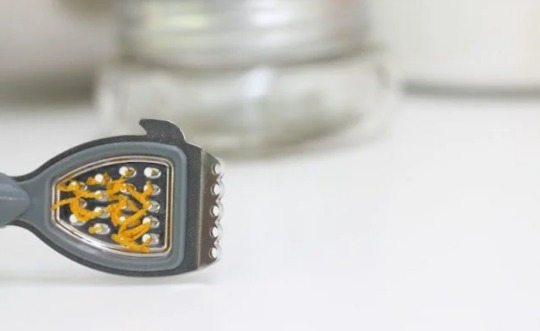
How to Make Exfoliating Body Scrub
This scrub is so easy to make. It only contains natural ingredients and no artificial food colorings.
Combine sugar and oil.
2. Add zest.
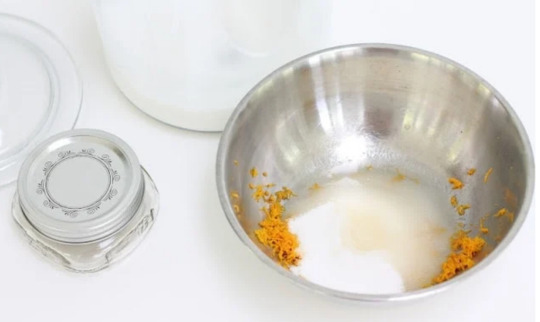
3. Scoop into sealable glass jars.
4. Label and date.
5. Store for up to 3 months in an airtight container.
Variations
This sugar scrub recipe is so easy to customize to fit your needs!
Citrus Variations – In this recipe I use orange, but any other citrus would work well! In the past, I have used grapefruit, orange, lime, and lemon. They all have worked wonderfully! If using lime I chose to use the zest from 2 limes since they are smaller sized fruit.
Oil Variations – Vitamin E Oil, Coconut Oil, Olive Oil, Almond Oil, Carrot Oil, Argan Oil, Jojoba Oil, and Grapeseed Oil.
Sugar Variations – Any white sugar should work well in this recipe. Sugar is used for a gentle exfoliation so keep that in mind when choosing the coarseness of the sugar.
For a winter sugar scrub try adding a dash of ground cloves or ground cinnamon.
Add a few drops of essential oils. My favorite combinations include other citrus oils to complement and enhance, floral scents such as moroccan rose or lavender, and woody scents such cedar or rosemary.
Pro Tip: If using coconut oil, it will help to slightly warm the oil on the stovetop or even the microwave before adding it to the mixture. I love coconut oil and lime combination!
How to Store Sugar Scrub
This Sugar Scrub recipe can be stored for up to 3 months in a properly sealed jar / airtight container.
PRO TIP: Upcycle jars you already own!
#DIY Citrus Sugar Scrub#Summer Body Scrub Recipe#Homemade Exfoliating Scrub#Natural Skin Rejuvenation#Sensitive Skin Body Polish#Citrus Zest Beauty Products#Vitamin E Oil Benefits#Kitchen Ingredients Skin Care#Gift Ideas: DIY Sugar Scrub#How to Make Sugar Scrub
8 notes
·
View notes
Text
hello! welcome to blog post #2! i was real stoned while writing that last post so ive been reading it a lot to make sure i said everything right. it made me think today about “eating healthy for cheap…” i mentioned lots of canned and frozen foods because i had fruits and vegetables in mind, but i want to clarify that senshi needs more than just fruits and veggies and WE DO TOO!! senshi complains about adventures meals commonly avoiding fruits and vegetables, and is persistent about the importance of a BALANCED meal. just like he said- you need fats, carbs, fruits, veggies (and more)!
i see people now are far too worried about how much protein or calories they’re getting, and health blogs barely ever mention vitamins anymore. nobody wants to talk about the yucky stuff, like fiber and digestion. digestion is easily one of the most important functions in your body (i believe) and you can do a lot for yourself by taking care of it!
since a lot of my health issues have been centered around my stomach and my vitamin levels, i focus on fiber. but if you live in america, you should too because you’re at risk of having the same deficiencies i have! 🫵 most americans don’t meet their fiber goal daily, and many people struggle with constipation as a part of their daily life. that will make you grouchy and more easily overstimulated + tons of other stuff!!! for some people and in my case, your body won’t always digest stuff right if there’s not enough fiber and you may not absorb the nutrients you’re eating. it’s actually recommended to try and consistently get vitamins from your diet and not pills, because you absorb it better when you eat it (just like the medicine senshi said worked better when cooked!) that’s also why it’s so important to hit all your food groups. carbs aren’t an issue, btw- you just need to make sure you’re eating healthy grains. i have a gluten allergy so i actually make most (hopefully all soon) of my carb foods from scratch (waffles, bread, pasta) which gives me more opportunity to pick what grains i get. not everyone has time to bake from scratch though, so oatmeal, wild rice, and popcorn are all some great cheap/easy grains to get in you!
(here’s the mayo clinic guide to grains. they have a guide about fiber too i can send to anyone interested. i’m a patient at mayo with their gender clinic team and i trust them as a resource, but don’t forget to talk to your nutritionist or doctor to figure out what you need and what would be best for you. don’t be afraid to ask them questions, it’s their job!)
you should be getting good fats too. avocados/avocado oil, olive oil, and oily fish like salmon are all some great examples of healthy fats. if you like to bake and you’re up for a challenge, i made butter-free cheese danishes for a friend this year using avocados as fat in the pastry dough!
probiotics can be found in things that are fermented, like yogurt or even olives and apple cider vinegar.
when it comes to meat, i know some people say red or white is healthier, but i cannot stress the importance of talking to your doctor about it!! people with certain medical conditions or allergies may not be able to eat certain meats, and there may be some meats that you should be eating MORE bc of your body or genetics. if you don’t eat meat or only eat red or white meat for any reason, let your doctor/pcp know so you can figure out if you need supplements.
when it comes to fruit and vegetables i get a wide variety since they’re easiest for me to put more of while i cook, so i honestly haven’t checked out what vegetables i SHOULD be targeting. however, when i buy fruit i aim for things high in fiber to help me hit my fiber goal (like oranges!) or i buy fruit that helps with anti-inflammatory stuff. i don’t remember what about the fruit/berries helps but i aim for blueberries and pomegranates. pomegranates really aren’t messy if you open them in a bowl or strainer under running water, and they can be as low as $1 some places for maybe 1/3 cup of seeds? not bad!
but anyways, that’s pretty much all i know so far. becoming informed about what your body needs can open up a lot of new dietary options for you that are still affordable. getting a balanced and nutritious meal should be more accessible but just like senshi we can help, encourage, and educate ourselves and our friends to build a better community. let’s figure out the right path to affordable and sustainable health, together!!
love, senshi’s #1 fan
#if you can reblog this with things YOU know about digestion or food that would be awesome#luneski blog post 2#delicious in dungeon#senshi#senshi dungeon meshi#dungeon meshi#senshi tips#life tips#health tips#diet tips
3 notes
·
View notes